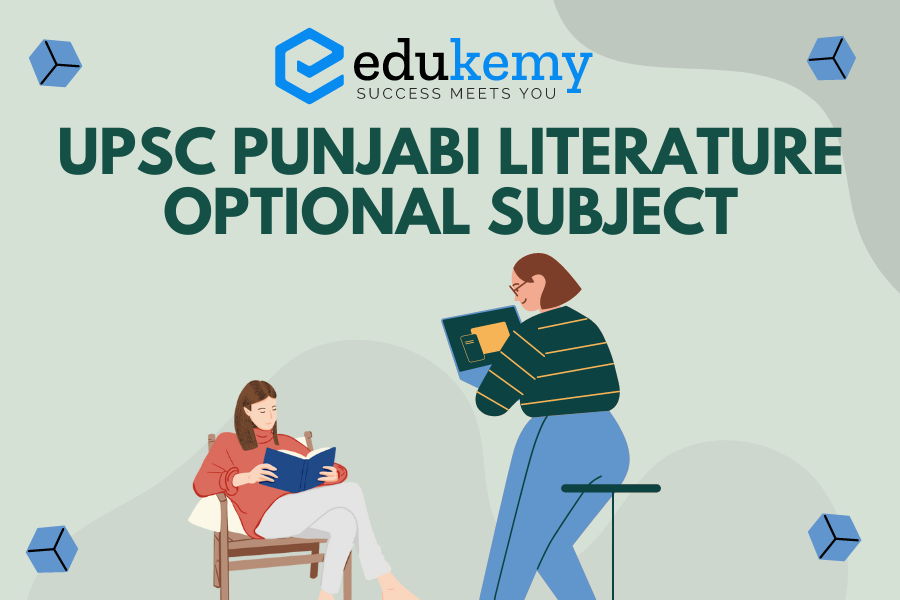
Embark on a journey into the vibrant world of Punjabi literature, a rich tapestry woven from the history, culture, and social fabric of Punjab. As an optional subject for the UPSC Civil Services Examination, Punjabi literature delves not only into the evolution of the Punjabi language and its unique script, Gurmukhi, but also explores the diverse literary traditions that have flourished over centuries. This in-depth exploration equips you with a deeper understanding of Punjabi society and its influence on the broader Indian landscape.
Contents
- 1 Punjabi Paper 1
- 2 Punjabi Paper 2
- 3 FAQs on Punjabi Literature Optional Subject – UPSC
- 3.1 1. Is Punjabi Literature a good choice for the UPSC Optional Subject?
- 3.2 2. What does the UPSC Punjabi Literature syllabus cover?
- 3.3 3. What are the resources available for studying Punjabi Literature for UPSC?
- 3.4 4. How can I improve my answer writing for Punjabi Literature in the UPSC exam?
- 3.5 5. Are there any coaching institutes specializing in Punjabi Literature for UPSC?
- 4 In case you still have your doubts, contact us on 9811333901.
Punjabi Paper 1
Section – A
(a) Origin of Punjabi Language; different stages of development and recent development in Punjabi Language; characteristics of Punjabi phonology and the study of its tones; classification of vowels and consonants.
(b) Punjabi morphology; the number-gender system (animate and inanimate), prefixes, affixes and different categories of Post positions; Punjabi word formation; Tatsam. Tad Bhav. forms; Sentence structure, the notion of subject and object in Punjabi; Noun and verb phrases.
(c) Language and dialect: the notions of dialect and idiolect: major dialects of Punjabi: Pothohari, Majhi, Doabi, Malwai, Paudhi; the validity of speech variation on the basis of social stratification, the distinctive features of various dialects with special reference to tones Language and script; origin and development of Gurumukhi; Suitability of Gurumukhi for Punjabi.
(d) Classical background: Nath Jogi Sahit.
Medieval Literature: Gurmat, Suti, Kissa and Var: janamsakhis.
Section – B
(a) Modern trends – Mystic, romantic, progressive and neomystic (Vir Singh, Puran Singh, Mohan Singh, Amrita Pritam, Bawa Balwant, Pritam Singh Safeer, J. S. Neki). Experimentalist (Jasbir Singh Ahluwalia, Ravinder Ravi, Ajaib Kamal). Aesthetes (Harbhajan Singh, Tara Singh). Neo-progressive (Pash, Jagtar, Patar).
(b) Folk Literature – Folk songs, Folk tales, Riddles, Proverbs.
Epic – (Vir Singh, Avtar Singh Azad, Mohan Singh).
Lyric – (Gurus, Sufis and Modern Lyricists-Mohan Singh, Amrita Pritam, Shiv Kumar, Harbhajan Singh).
(c) Drama – (I.C. Nanda, Harcharan Singh, Balwant Gargi, S.S. Sekhon, Charan Das Sidhu)
Novel – (Vir Singh, Nanak Singh, Jaswant Singh Kanwal, K.S. Duggal, Sukhbir, Gurdial Singh, Dalip Kaur Tiwana, Swaran Chandan).
Short Story – (Sujan Singh, K. S. Virk, Prem Parkash, Waryam Sandhu).
(d) Socio-cultural – Sanskrit, Persian and Western. Literary influences;
Essay – (Puran Singh, Teja Singh, Gurbaksh Singh).
Literary Criticism – (S.S. Sekhon, Attar Singh, Kishan Singh, Harbhajan Singh, Najam Hussain Sayyad).

Punjabi Paper 2
Section – A
(a) Sheikh Farid – The complete Bani as includedin the Adi Granth.
(b) Guru Nanak – Japu Ji. Baramah. Asa di Var.
(c) Bulleh Shah – Kafian
(d) Waris Shah – Heer
Section – B
(a) Shah Mohammad – Jangnama (Jang Singhante Firangian)
Dhani Ram Chatrik – Chandan Vari
(Poet) – Sufi Khana; Nawan Jahan
(b) Nanak Singh – Chitta Lahu
(Novelist) – Pavittar Papi; Ek Mian Do Talwaran
(c) Gurbaksh Singh Zindagi-di-Ras
(Essayist) – Nawan Shivala; Merian Abhul Yadaan.
Balraj Sahni – Mera Roosi Safarnama
(Travelogue) – Mera Pakistani Safarnama
(d) Balwant Gargi – Loha Kutt
(Dramatist) – Dhuni-di-Agg; Sultan Razia
Sant Singh Sekhon – Sahityarth
(Critic) – Parsidh Punjabi Kavi; Punjabi Kav Shiromani.
FAQs on Punjabi Literature Optional Subject – UPSC
1. Is Punjabi Literature a good choice for the UPSC Optional Subject?
Answer: It can be a good choice if you have a strong foundation in Punjabi language and literature. It can be a scoring subject if you develop a good understanding of the syllabus and write well. However, it might be a niche subject compared to others, so consider your strengths and interests before choosing.
2. What does the UPSC Punjabi Literature syllabus cover?
Answer: The syllabus is divided into two papers: Paper I and Paper II. Paper I covers the history of Punjabi language and literature, ancient, medieval, and modern periods. Paper II focuses on specific literary forms like poetry, drama, and prose, along with literary criticism and thinkers. You can find the detailed syllabus on the UPSC website (https://upsc.gov.in/examinations/revised-syllabus-scheme).
3. What are the resources available for studying Punjabi Literature for UPSC?
Answer: There are textbooks by Punjabi literature scholars, previous years’ UPSC question papers, and study materials from coaching institutes. Additionally, Punjabi literary magazines and online resources can be helpful. Consider talking to UPSC candidates who have succeeded with Punjabi Literature for guidance.
4. How can I improve my answer writing for Punjabi Literature in the UPSC exam?
Answer: Practice writing answers in Punjabi using relevant terminology and critical analysis. Focus on clarity, structure, and presenting a well-rounded argument. Time management is crucial, so practice writing within the UPSC time limit. Analyze toppers’ answers (if available) to understand effective writing techniques.
5. Are there any coaching institutes specializing in Punjabi Literature for UPSC?
Answer: Yes, some coaching institutes offer guidance specifically for Punjabi Literature as an optional subject. Look for institutes with experienced faculty and a proven track record. Remember, coaching is a supplement, and self-study is essential for success.
In case you still have your doubts, contact us on 9811333901.
For UPSC Prelims Resources, Click here
For Daily Updates and Study Material:
Join our Telegram Channel – Edukemy for IAS
- 1. Learn through Videos – here
- 2. Be Exam Ready by Practicing Daily MCQs – here
- 3. Daily Newsletter – Get all your Current Affairs Covered – here
- 4. Mains Answer Writing Practice – here

